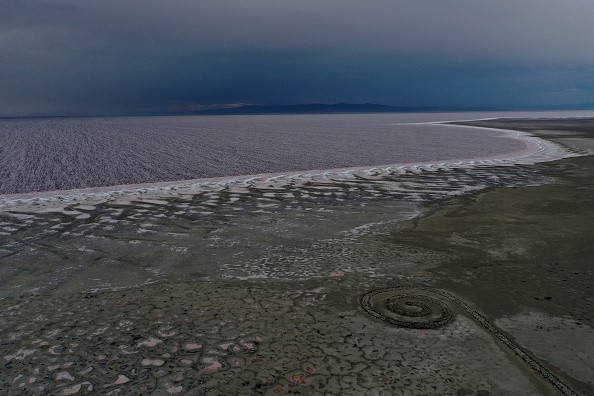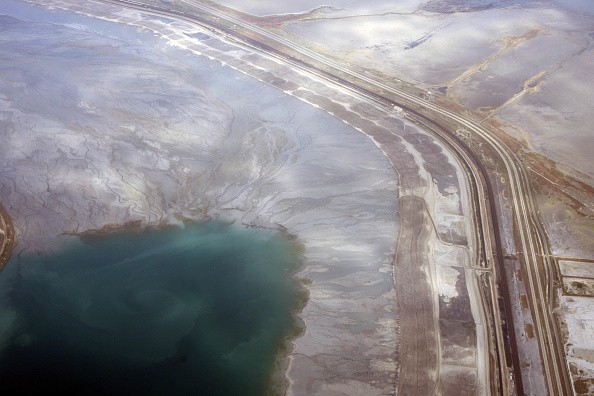New drone footage reveals the Great Salt Lake's deplorable condition. Water levels at the renowned Utah lake reached an all-time low this week, and drone footage demonstrates why one official said, "it's evident the lake is in trouble."

Hitting an All-Time Low
On Sunday, Utah's Great Salt Lake water reached a new historic low, and experts predict that levels will continue to fall for the next few months. A new drone video filmed by a Utah homeowner illustrates in graphic detail how bad the situation at the famed lake has become due to the continuing megadrought.
The lake's average daily surface water height was 4,190.1 feet on July 3 at the U.S. Saltair Boat Harbor on the lake's southern end has a Geological Survey gauge. Last year, on July 23, the same gauge reported an average daily level of 4191.3 feet, and by late October, the water level had dropped to 4,190.2 feet.
Continuing to Plummet
Officials expect lake levels to continue to plummet until the fall or early winter when storms arrive and agricultural irrigation ceases for the season. Drought in the West has been worsened by climate change, and water diversions from the Bear River Watershed have long contributed to its depletion.
Scott Taylor of Magna, Utah, close southeast of the lake and in the suburbs of Salt Lake City, captured some drone footage this week that shows how much the body of water has dried out in recent years.
Taylor's video depicts a series of pilings protruding from the dry soil, pilings formerly part of Saltair, a now-defunct lake resort. The pilings were once completely submerged, but as Taylor's film reveals, they can now be seen projecting from the uncovered lakebed for approximately a mile, right up to the water's edge.
The Salt Lake Tribune, one of America's oldest continuously published newspapers west of the Mississippi River, asked AccuWeather mapmakers, with whom the publication partners, to redraw the lake in 2021 due to the lake's falling water levels.
Almost Half its Original Size

With the lake almost half its original size, the newsroom decided to raise awareness about how much the lake has changed in recent years and to reflect the lake's current situation better appropriately.
Grant Burningham described the lake's situation as a "death spiral" linked to the area's environment and economics.
If the Great Salt Lake continues to dry up, Utah's economic toll may range from $1.69 billion to $2.17 billion each year, resulting in roughly 6,500 job losses, according to a 2019 state study. The evaluation underlines that these expenses might be as high as $25.4 billion to $32.6 billion for 20 years.
At Risk
According to a 2012 analysis included in the evaluation, the lake provides an estimated $1.32 billion to Utah's annual economy. This estimate, however, is in 2010 dollars. The estimate comes to at least $1.77 billion when inflation is factored in.
The health of the almost 3 million people who live surrounding the Great Salt Lake will also be affected because exposed lakebed dust has arsenic levels.
Utah lawmakers, anxious for a solution to the deteriorating situation, agreed earlier this year to commission a study on the possibility of pumping water from the Pacific Ocean to replenish the Great Salt Lake.
According to KUTV, Utah Representative Carl Albrecht remarked at the time, "Severe times call for dire measures." "Water will become more valuable for drinking, sewage, and irrigation." We have piped all around the nation carrying gas, oil, and everything else."
Other Reservoirs
Meanwhile, other lakes and reservoirs throughout the West have suffered due to the severe drought and water diversions.
Water levels in Lake Mead, a reservoir built by the Hoover Dam and located between Arizona and Nevada, hit its lowest since the lake was filled in the 1930s in late June. The reservoir is the largest in terms of volume in the country.
Lake Mead and its dropping water levels drew global attention after the federal government declared a water emergency for the first time since its creation in August 2021. According to the Bureau of Reclamation, water levels at the reservoir plummeted an additional 26 feet from June 2021 to June 2022. Water levels are expected to drop until the wet season begins in November.
Related Article : Another Body Found in Lake Mead As Water Level Continues to Drop
For more climate and weather updates, don't forget to follow Nature World News!
© 2025 NatureWorldNews.com All rights reserved. Do not reproduce without permission.





